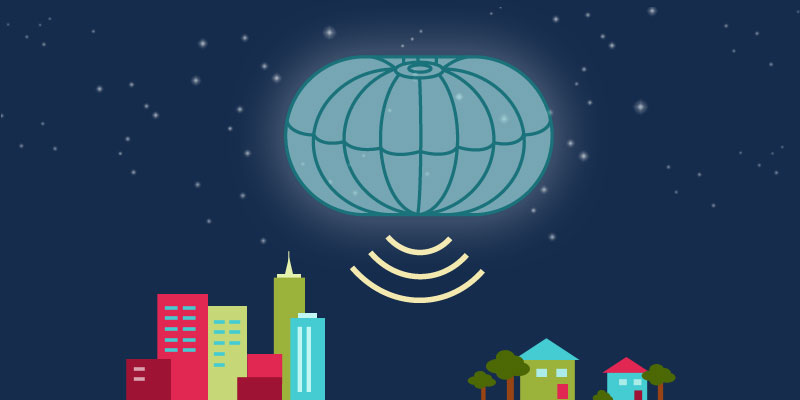If you thought helium balloons were just for fun, you’re wrong. Well at least according to Google. In 2013, the tech-company started a project named ‘Project Loon’, simply translated as ‘a crazy project’. Helium balloons, equipped with Wi-Fi-technology, should provide internet access to distant and often rural areas that momentarily don’t have access to the world wide web.
These enormous balloons, which have a diameter of approximately 15 meter, operate in the stratosphere at altitudes between 18 km and 25 km. These altitudes are especially suitable because there are relatively low wind speeds and there is little turbulence. The height of the balloons can be adjusted by using advanced software algorithms. By adjusting and optimizing the altitude, Google believes it can roughly keep the balloons at the same location in the air. This allows a fleet of balloons to be coordinated in such a way to guarantee there is always one balloon flying over a specific region. The balloons are equipped with batteries – that run on solar energy – which provides the necessary equipment in the balloons with electricity.
Applications
The balloons can be used to deliver access to parts of the world that are currently badly connected to the internet. In some remote areas it isn’t cost effective to provide internet access by traditional underground fiber cables. Another application is the use of these balloons in the case of an emergency, like natural disasters. Balloons can be send to affected regions to improve communication between e.g. survivors and emergency services.
Challenges
There are however still some challenges to face. The sturdiness of the balloons is yet not optimal, which means that they have a limited time to fly. Naturally, the longer the balloons stay up, the lower the operating costs. Nowadays, the maximum ‘up-time’ is just about 130 days. The safety part have to be addressed as well. Since 2014, around 10 balloons have crashed or landed at buildings. Moreover, when it comes to full implementation in the future, coordination and communication with other flying objects have to be improved too.
Altogether, Project Loon has some great opportunities that can lead to improved internet access for the world’s poorest regions and people. Do you believe in this project?
Sources:
– Simonite, T. (2015) ’10 Breakthrough Technologies 2015: Project Loon’ MIT Technology Review, 2015


Thanks for sharing your blog Jesse. I had never heard of Project Loon before, but the innovation sounds really interesting. I literally use Internet everyday and I think that it is important to make it available all over the world. Today, more than half of the world’s population is still without Internet access. Internet connectivity is a problem in rural and remote areas and I think that extending this Internet connectivity can improve the communication and efficiency of your Internet use. You have already mentioned the advantage of the balloons in case of an emergency. I think that this is a really important one. Last week I watched a documentary about 9/11. One of the major problems was the loss of Internet connection, which resulted in communication chaos and a slower rescue process. These balloons could prevent and solve these issues in the future.
However, safety always comes first and I think that it is important to optimize the launching, navigating and recovery process. Every 30 seconds a balloon is launched, so this highlights the large scale of the balloons in the stratosphere. Project Loon implemented a lot of technologies already to ensure safety. For example, they track the location of every balloon using GPS and they coordinate directly with the local air traffic control to bring each balloon safely to the ground. The crashes of the 10 balloons are part of the learning process and believe that this balloon is safe enough to work with. I hope to hear more of these balloons and their benefits in the future!
Thanks Jesse for sharing this blog, project loon sounds intresting but i think there are some major challenges to overcome. You have mentioned the problems with the flight time and the safety of the loom ballons, but there is also a challenge in international politics. To reach rural areas google must coordinate there ballons trough international airspace. This means that the ballons will fly over countries who are enemies of the united states, for example Irak and Russia. Before project loon can be launched Google must convince several different regulators across the world. I think this is the biggest challenge for Google to overcome, because when governments do not allow a Loom ballon then it can not reach rural and distant areas and project Loom will fail. Furthermore google becomes a global ISP(Internet Provider Security) and therefore they have to consider the regulations according IPS, for example who can have access to the Loom network and what google can charge. I hope project Loom will succeed but i think that the political challenge its to big to overcome. The idea behind project Loom is very noble but i think google did’t consider the political challenge and the international regulations according the airspace.